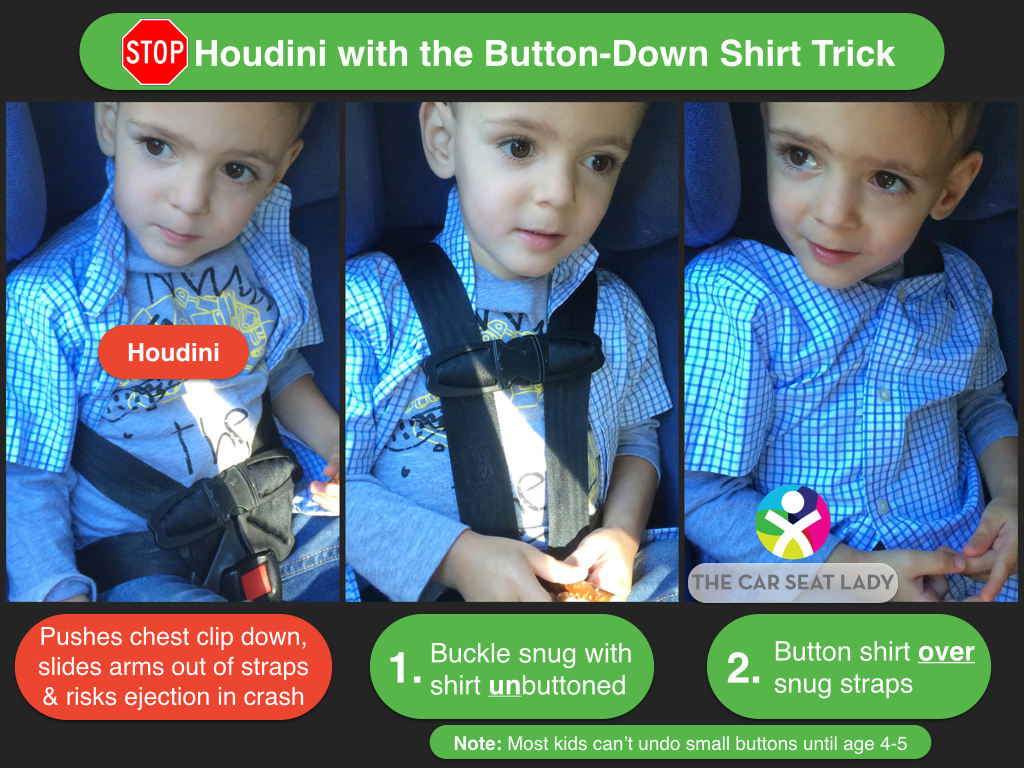What is the best way to stop a toddler from unbuckling their chest clip? The most effective methods involve addressing the underlying reasons for the behavior, implementing car seat safety solutions like chest clip guards, and consistently reinforcing the importance of car seat safety. This blog post provides detailed strategies to prevent your toddler from turning their car seat into an escape route, ensuring their safety on every journey.

Image Source: thecarseatlady.com
The Great Toddler Escape Artist: Why They Do It
Before diving into solutions, it’s helpful to figure out why your little one is so determined to break free. Toddlers are curious, independent, and often easily bored. Knowing the ‘why’ can help you pick the right approach to stop the toddler chest clip escape.
Boredom and Restlessness
Long car rides can feel like an eternity to a toddler. They may unbuckle the chest clip simply because they’re tired of sitting still and want to explore.
Seeking Attention
Sometimes, unbuckling the chest clip is a cry for attention. They might know that doing so will get a reaction from you, even if it’s negative.
Testing Boundaries
Toddlers are constantly testing boundaries and trying to understand what they can and can’t do. Unbuckling the chest clip might be their way of seeing what happens when they push the limits.
Discomfort
If the chest clip is too tight or the car seat is uncomfortable, your toddler might be trying to alleviate that discomfort by unbuckling.
Car Seat Safety Solutions: Fortifying the Fortress
Now, let’s explore practical car seat safety solutions to stop toddler unbuckling their chest clip. These methods focus on physically deterring your child and reinforcing safe behavior.
The Power of Distraction
A well-timed distraction can often prevent a toddler chest clip escape before it even starts.
- Toys: Keep a stash of car-only toys that are new or rotated frequently to maintain their interest.
- Books: Board books or picture books can provide entertainment and keep little hands busy.
- Music: Sing-alongs or audiobooks can be engaging and distracting.
The Chest Clip Guard: A Physical Barrier
A chest clip guard toddler device is a plastic or fabric shield that fits over the chest clip, making it difficult for your child to reach and unbuckle. These guards can be very effective.
Types of Chest Clip Guards:
| Type | Description | Pros | Cons |
|---|---|---|---|
| Hard Plastic Guard | Rigid plastic shield that covers the chest clip. | Very difficult for toddlers to open; durable. | Can be bulky; may interfere with car seat fit; potential projectile in an accident. |
| Fabric Guard | Fabric cover with a closure (like Velcro) over the chest clip. | Softer and less bulky than plastic; may be more comfortable. | Can be easier for determined toddlers to defeat; less durable than plastic. |
| Integrated Car Seat | Some car seats come with built-in chest clip locking mechanisms. | Designed for safety; integrated into the car seat. | Can be expensive; may not be compatible with existing car seats. |
Important Note: Always check with your car seat manufacturer to ensure that any aftermarket chest clip guard toddler device is safe to use with your specific car seat model. Using unapproved accessories can void your warranty and potentially compromise the car seat’s safety performance in a crash.
The Buckle Guard: Another Layer of Defense
Similar to a chest clip guard, a car seat buckle guard prevents your child from unbuckling the entire harness system. This device covers the release button on the buckle, making it difficult for little fingers to press.
Choosing the Right Buckle Guard:
- Compatibility: Ensure the guard is compatible with your car seat’s buckle.
- Ease of Use for Adults: You should be able to easily unbuckle the harness in an emergency.
- Safety: Look for guards that have been tested and meet safety standards.
Harness Tightness: A Secure Fit
A properly fitted harness is crucial for car seat safety and can also deter toddler defeating car seat attempts. The harness straps should be snug enough that you can’t pinch any excess webbing at the child’s shoulder.
How to Check Harness Tightness:
- Place your fingers on the child’s collarbone.
- Try to pinch the harness webbing at the shoulder.
- If you can pinch any webbing, the harness is too loose.
- Tighten the harness until you can no longer pinch any webbing.
The Escape-Proof Chest Clip: Does It Exist?
While there’s no such thing as a truly escape proof chest clip, some car seats have features that make it much harder for toddlers to unbuckle themselves. Look for car seats with:
- Recessed Chest Clips: These clips are designed to be harder to reach and manipulate.
- Harness Adjustment Systems: These systems allow you to easily tighten the harness from the front, ensuring a snug fit.
- Locking Mechanisms: Some chest clips have a locking feature that requires a tool or specific action to open.
Preventing Toddler Car Seat Removal: Reinforcement and Education
Beyond physical barriers, teaching your child about car seat safety and reinforcing positive behavior is key to preventing toddler car seat removal.
Explain the Importance of Car Seat Safety
Talk to your toddler about why car seats are important. Use simple language they can understand.
- “Your car seat keeps you safe in the car.”
- “We need to stay buckled so we don’t get hurt.”
- “Car seats are like a special hug that keeps us safe.”
Positive Reinforcement: Rewarding Good Behavior
When your child stays buckled and behaves well in the car, reward them with praise, stickers, or small, non-food treats.
- “I’m so proud of you for staying buckled! Here’s a sticker.”
- “You’re doing such a great job in your car seat! Let’s sing your favorite song.”
Consistent Consequences: Addressing Unsafe Behavior
If your child unbuckles their chest clip, address the behavior calmly and firmly.
- “I see you unbuckled your chest clip. That’s not safe. We need to stay buckled.”
- Pull over to a safe location to re-buckle your child. This reinforces that unbuckling will result in an immediate stop to the journey.
- Avoid yelling or scolding, as this can escalate the situation.
The Car Seat as a Non-Negotiable
Make it clear that staying buckled in the car seat is not optional. It’s a rule that must be followed at all times.
- Be consistent with your expectations.
- Don’t give in to tantrums or pleas to be let out of the car seat.
Childproofing Car Seat Chest Clip: A Proactive Approach
Childproofing car seat chest clip involves taking steps to make it more difficult for your child to access and manipulate the clip.
Covering the Clip: A Simple Solution
Sometimes, simply covering the chest clip with a soft cloth or bib can deter your child from messing with it.
Redirecting Attention: A Change of Focus
If you see your child reaching for the chest clip, try to redirect their attention to something else.
- Offer them a toy.
- Start singing a song.
- Point out something interesting outside the window.
The Buddy System: Enlisting Help
If you have another adult in the car, ask them to keep an eye on your toddler and intervene if they start trying to unbuckle.
How to Secure Chest Clip Toddler: The Long-Term Strategy
How to secure chest clip toddler over the long term involves a combination of physical measures, behavioral reinforcement, and open communication.
Review and Adjust: Adapting to Change
As your child grows and develops, you may need to adjust your strategies. What works at one age may not work at another.
Collaborate with Your Child: Involving Them in the Process
As your child gets older, involve them in the process of car seat safety. Explain why it’s important and ask for their cooperation.
Seek Professional Advice: When to Get Help
If you’re struggling to keep your child safely buckled in their car seat, don’t hesitate to seek professional advice from a certified Child Passenger Safety Technician (CPST). They can help you:
- Ensure your car seat is properly installed and used.
- Troubleshoot any issues you’re experiencing.
- Recommend appropriate solutions for your child’s specific situation.
Fathoming Car Seat Safety: Key Considerations
- Read the Car Seat Manual: Familiarize yourself with your car seat’s instructions and guidelines.
- Register Your Car Seat: This allows the manufacturer to contact you in case of a recall.
- Inspect Your Car Seat Regularly: Check for any signs of wear or damage.
- Never Use a Car Seat That Has Been Involved in a Crash: Even if there’s no visible damage, the car seat may be compromised.
- Be Aware of Expiration Dates: Car seats have expiration dates, typically six to ten years from the date of manufacture.
FAQ: Addressing Common Concerns
Q: Can I just use duct tape to keep the chest clip closed?
A: No. Using duct tape or any other unapproved method to secure the chest clip is extremely dangerous and can compromise the car seat’s safety performance in a crash.
Q: What if my child is strong enough to break the chest clip guard?
A: Some children are exceptionally persistent and strong. If your child is able to defeat a chest clip guard, consider switching to a different type of guard or exploring other car seat safety solutions, such as a car seat with an integrated locking mechanism. A five-point harness system is the safest way to secure your child in the car.
Q: Is it ever okay to let my child out of their car seat while the car is moving?
A: No. It is never safe to let your child out of their car seat while the car is moving, even for a short period of time.
Q: What do I do if my child unbuckles while I’m driving on the highway?
A: Remain calm. Find a safe place to pull over as soon as possible. Re-buckle your child and reinforce the importance of staying buckled. If the behavior persists, consider seeking professional advice.
Q: My toddler defeated the car seat, and now seems inspired to try other things, where do I go from here?
A: Redirecting your toddler’s focus from the car seat will always be key. In order to move on and prevent boredom from turning into unsafe behavior, keep a rotation of new toys, games and books. It can also be helpful to create new challenges or learning experiences such as playing games that help build problem solving and creative thinking skills.
By implementing these strategies consistently, you can significantly reduce the likelihood of your toddler unbuckling their chest clip and ensure their safety on every car ride. Remember, patience, persistence, and a proactive approach are essential for preventing toddler car seat removal and promoting safe travel habits.

Clark Lubowitz is a parenting expert with over 10 years of experience in toddler care and child development. Holding a degree in Early Childhood Education, he specializes in blending modern technology with parenting, offering expert advice on the best toddler gadgets. Through his work on ToddlerAwesome.com, Clark provides valuable insights to help parents make informed decisions for their little ones.
